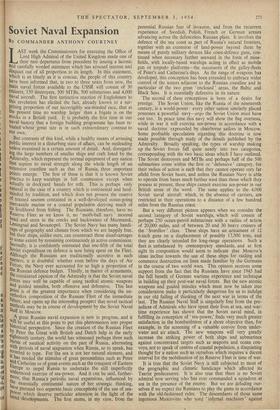Soviet Naval Expansion
BY COMMANDER ANTHONY COURTNEY AST week the Commissioners for executing the Office of Lord High Admiral of the United Kingdom made one of their rare departures from precedent by issuing a laconic and carefully worded statement which has aroused interest and disquiet out of all proportion to its length. In this statement, Which is as timely as it is concise, the people of this country have been informed that, in two to three years from now, the main naval forces available to the USSR will consist of 30 cruisers, 150 destroyers, 500 MTBs, 500 submarines and 4,000 naval aircraft. The first instinctive reaction of Englishmen to this revelation has elicited the fact, already known to a sur- prising proportion of our incorrigibly sea-minded race, that at the present time no warship larger than a frigate is on the Stocks in a British yard. It is probably the first time in our naval history that a foreign building programme has been re- vealed whose great size is in such extraordinary contrast to Our own.
But contrasts of this kind, while a healthy means of arousing Public interest in a disturbing state of affairs, can be misleading unless examined in a certain amount of detail. And, disregard- ing the large numbers of smaller ships and craft listed by the Admiralty, which represent the normal equipment of any nation that aspires to naval strength along the whole length of an extensive coastline such as that of Russia, three important Points emerge. The first of these is that it is known Soviet Practice to keep warships in full commission except when actually in dockyard hands for refit. This is perhaps only natural in the case of a country which is continental and land- Minded by tradition, and which does not possess the reserve of trained seamen contained in a well-developed ocean-going mercantile marine or a coastal population deriving much of Its livelihood from fishing. The Russians, therefore, have no Reserve Fleet as we know it, no 'moth-ball navy' moored head- and stern in the creeks and backwaters of Murmansk, Leningrad and Sevastopol. The Soviet Navy has many handl- naPs of geography and climate from which we are happily free, but their ships, unlike ours, can counteract these disadvantages to some extent by remaining continuously in active commission. `3econdly, it is confidently estimated that one-fifth of the total Soviet expenditure on defence is now being spent on the Fleet. Although the Russians are traditionally secretive in such 'natters, it is doubtful whether even before the days of Air voices, the Navy ever accounted for so high a proportion of the Russian defence budget. Thirdly, in matter of armaments, forces considered opinion of the Admiralty is that the Soviet naval torces may well be capable of using tactical atomic weapons and guided missiles, both offensive and defensive. This last Point is of the greatest importance when considering the un- orthodox composition of the Russian 'Fleet of the immediate future, and opens up the interesting prospect that novel tactical nit, ethods may be in course of development by the Soviet Naval Staff in Moscow.
A great Russian naval expansion is now in progress, and it l'lli be useful at this point to put this phenomenon into proper historical storical perspective. Since the creation of the Russian Fleet I Peter the Great with British and Dutch help in the early ekighteenth century, the world has witnessed perhaps three such oursts of nautical activity on the part of Russia, alternating With periods of naval stagnation when Russia, so to speak, has !everted to type. For the sea is not her natural element, and it has needed the stimulus of great personalities such as Peter tnd Catherine or of great events such as the conquest of Eastern understood exercise of sea-power. And it can be said, further- %ere, that Russia's periodic naval expansions, influenced by have essentially continental nature of her strategic thinking, 'aye pursued two separate .basic conceptions• of the use of sea- Power which deserve particular attention, in the light of the latest developments. The first stems, in my view, from the perennial Russian fear of invasion, and from the recurrent experience of Swedish, Polish, French or German armies advancing across the defenceless Russian plain. It involves the defence of the 'sea coast as part of Russia's natural frontiers, together with an extension of land-power beyond them by means of purely military devices like coast-defence guns, con- tinued when necessary further seaward in the form of mine- fields, with locally-based warships acting in effect as mobile gun or torpedo platforms—the successors of the galley-fleets of Peter's and Catherine's days. As the range of weapons has developed, this conception has been extended to embrace wider control of the waters adjacent to the Russian coastline and in particular of the two great enclosed ' areas, the Baltic and Black Seas. It is essentially defensive in its nature.
The second of these conceptions is born of a desire for prestige. The Soviet Union, like the Russia of the nineteenth century, is a world-power : every other nation similarly placed possesses a powerful navy—ergo the Soviet Union must have one too. In peace time this navy will show the flag overseas, while in war it will exercise sea-power in accordance with a naval doctrine expounded by chairborne sailors in Moscow. Some profitable speculation regarding this doctrine is now made possible through study of the details published by the Admiralty. Broadly speaking, the types of warship making up the Soviet forces fall quite neatly into two categories, corresponding with the two basic ideas which I have outlined. The Soviet destroyers and MTBs and perhaps half of the 500 submarines come within the first or `defensive' category, for their radius of action is such that they cannot operate very far Afield from Soviet bases, and unless the Russian Navy is able to operate from bases much further west than those which they possess at present, these ships cannot exercise sea-power in our British sense of the word. The same applies to the 4,000 Soviet naval aircraft which, in the absence of carriers, are restricted in their operations to a distance of a few hundred miles from the Russian coast.
But a very different picture appears when we consider the second 'category of Soviet warships, which will consist of perhaps 250 ocean-patrol submarines with a radius of action of 20,000 miles, and of between 20 and 30 heavy cruisers of the Sverdlov ' class. These ships have an armament of 12 6-inch guns on a displacement of possibly 17.500 tons, and they are clearly intended for long-range operations. Such a fleet is unbalanced by contemporary standards, and at first sight its composition would seem to indicate that Moscow's ideas incline towards the use of these ships for raiding and commerce destruction on lines made familiar by the Germans in the course of two world wars. This opinion receives some support from the fact that the Russians have since 1945 had the full benefit of German wartime experience and technique in building up their post-war naval forces. But the new atomic weapons and guided missiles which must now be taken into consideration make it particularly dangerous for us to indulge in our old failing of thinking of the next war in terms of the -last. The Russian Naval Staff is singularly free from the pre- judices of Admirals who have spent their lives at sea, and war- time experience has shown that the Soviet naval mind, in fulfilling its conception of sea-power,' finds very much greater satisfaction in the bombardment of a shore objective than, for example, in the screening of a valuable convoy from under- water and air attack. The new weapons will very greatly increase the striking power of both ships and submarines against concentrated targets such as seaports and ocean con- voys, not to speak of centres of coastal population, a disquieting thought for a nation such as ourselves which requires a decent interval for the mobilisation of its Reserve Fleet in time of war.
It is true that the Soviet Navy is still subjected to most of the geographic and climatic handicaps which affected its Tsarist predecessors. It is also true that there is no Soviet admiral now serving who has ever commanded a squadron at sea in the presence of the enemy. But we are deluding our- selves if we expect the Russians to play the game in accordance with the old-fashioned rules. The descendants of those same ingenious Muscovites who used internal machines' against our ships in the Gulf of Finland a hundred years ago are building an unorthodox kind of fleet on an unprecedented scale. Such a fleet, irrespective of the nation building it, must be considered as a potential menace to the long lines of sea- communication by which we live. The counter to it must also depend ultimately on ships, whose form, speed and armament it is for the Admiralty and the NATO authorities to decide. But it is hardly likely that this counter will be found among the superannuated veterans of our wartime navy which make up the bulk of the British Fleet at the present time. On the contrary, we must build—and build quickly. That is the plain issue which Their Lordships have now placed squarely before the British people.



































 Previous page
Previous page